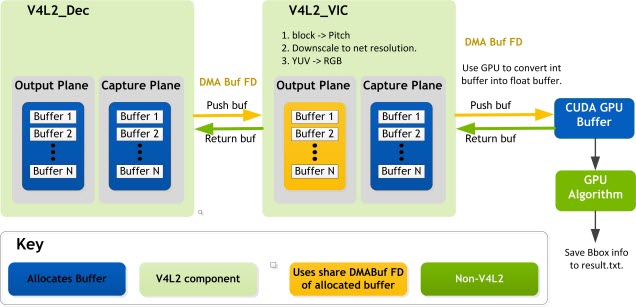|
|
L4T Multimedia API Reference28.1 Release |
|
|
L4T Multimedia API Reference28.1 Release |
This sample demonstrates the simplest way to use NVIDIA® TensorRT™ to decode video and save the bounding box information to the result.txt file. TensorRT was previously known as GPU Inference Engine (GIE).
This samples does not require a Camera or display.
$ cd $HOME/tegra_multimedia_api/samples/04_video_dec_trt $ make
$ ./video_dec_trt <in-file> <in-format> [options]
02_video_dec_cuda can verify the result and scale the rectangle parameters with the following command: $ ./video_dec_cuda <in-file> <in-format> --bbox-file result.txt
../../data/Model/GoogleNet_one_class/GoogleNet_modified_oneClass_halfHD.prototxtand the model file is:
../../data/Model/GoogleNet_one_class/GoogleNet_modified_oneClass_halfHD.caffemodel
GoogleNet_modified_oneClass_halfHD.prototxt, but is limited by the available system memory.$ rm trtModel.cache
The data pipeline is as follow:
Input video file -> Decoder -> VIC -> TensorRT Inference -> Plain text file with Bounding Box info
The sample does the following:

The block diagram contains not only the pipeline, but also the memory sharing information among different engines, which can be a reference for the other samples.
This sample uses the following key structures and classes:
The global structure context_t manages all the resources in the application.
| Element | Description |
|---|---|
| NvVideoDecoder | Contains all video decoding-related elements and functions. |
| NvVideoConverter | Contains elements and functions for video format conversion. |
| EGLDisplay | The EGLImage used for CUDA processing. |
| conv_output_plane_buf_queue | Output plane queue for video conversion. |
| TRT_Context | Provide a series of interfaces to load Caffemodel and do inference. |
| Member | Description |
|---|---|
| decCaptureLoop | Get buffers from dec capture plane and push to converter, and handle resolution change. |
| Conv outputPlane dqThread | Return the buffers dequeued from converter output plane to decoder capture plane. |
| Conv captuerPlane dqThread | Get buffers from conv capture plane and push to the TensorRT buffer queue. |
| trtThread | CUDA process and doing inference. |
$ ./video_dec_cuda <in-file> <in-format> --bbox-file result.txt
The default deploy file is
GoogleNet-modified.prototxt
The default model file is
GoogleNet-modified-online_iter_30000.caffemodel
In this directory:
$SDKDIR/data/model
End-of-stream (EOS) process:
a. Completely read the file.
b. Push a null v4l2buf to decoder.
c. Decoder waits for all output plane buffers to return.
d. Set get_eos:
decCap thread exit
e. End the TensorRT thread.
f. Send EOS to the converter:
conv output plane dqThread callback return false conv output plane dqThread exit conv capture plane dqThread callback return false conv capture plane dqThread exit
g. Delete the decoder:
deinit output plane and capture plane buffers
h. Delete the converter:
unmap capture plane buffers
./video_dec_trt <in-file> <in-format> [options]
| Option | Description |
|---|---|
--trt-deployfile | Sets deploy file name. |
--trt-modelfile | Sets the model file name. |
--trt-float32 <int> | Specifies to use float16 or not[0-2], where <int> is one of the following:
|
--trt-enable-perf | Enables performance measurement. |